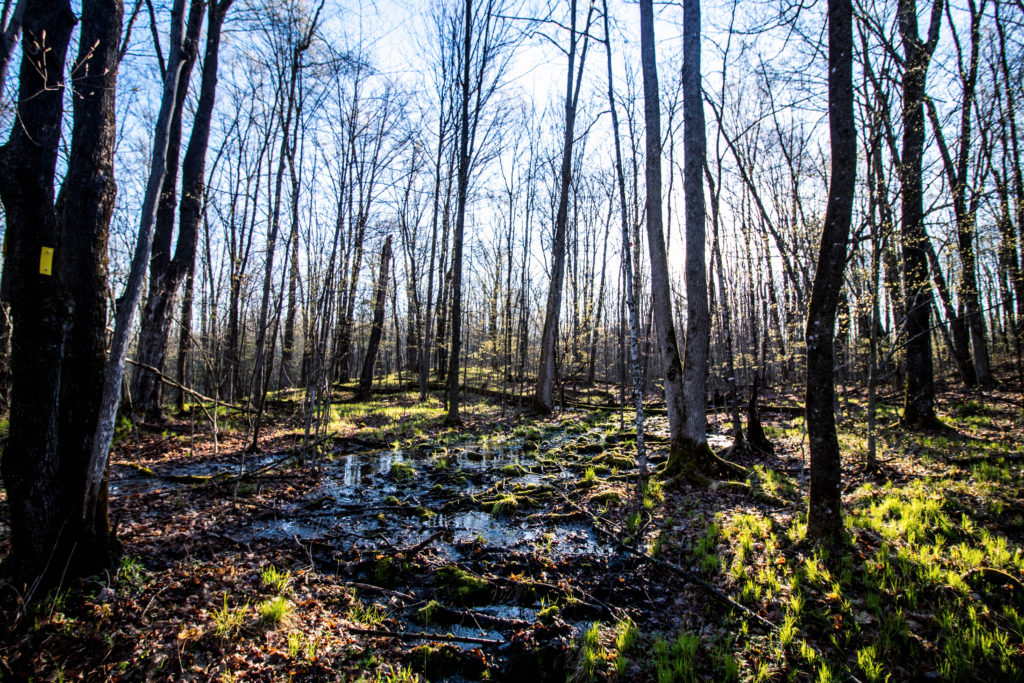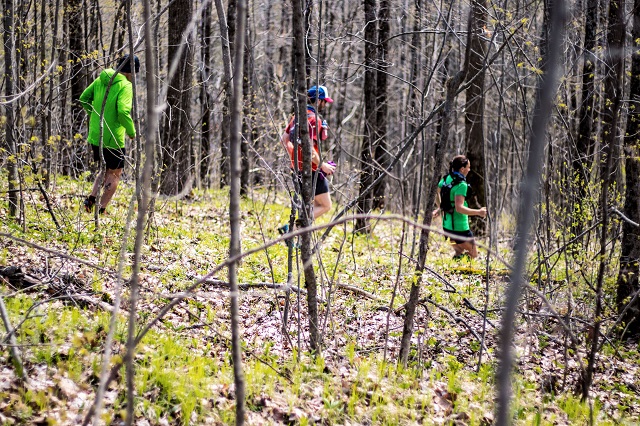
Wet spring trails greeted Annie Weiss as she traveled through the Northwoods.
Photo by Long Nguyen.
by guest writer Jonnah Perkins
When you mention the Ice Age National Scenic Trail, most people picture the civilized, buffed out trails of the southern and eastern segments. These trails are heavily trafficked by runners and hikers, flocking to the beauty of the forest, from Milwaukee, Madison, and Chicago. Farther up in the northern part of the state, there are wild, remote sections of trail many would not imagine could be found in Wisconsin.
This adventure is exactly what ultrarunner Annie Weiss was after when planning an attempt to break the fastest known time (FKT) on the Ice Age Trail. The personal time-trial-trend is growing in popularity in the ultrarunning community. Setting a new FKT, or even pursuing one, is a coveted notch on the belt of ultrarunners. On May 1st, Annie set out to complete the roughly 1,200 miles of the trail system in 19 days. That’s three days ahead of the current record of 22 days and 6 hours set by Jason Dorgan in 2007. This meant Annie would need to average over 60 miles per day to meet her goal. When I talked with Annie a few weeks ahead of her departure, she was brimming with optimism and a healthy dose of trepidation for completing her plan, especially the northern segments.

Annie Weiss, all smiles at the western terminus, faces her adventure full of possibility.
Photo by Carrie Highman, Dream Lens Media.
Annie started her voyage at the western terminus in St Croix Falls, just across the Minnesota border in Polk County. From there, the Ice Age Trail traverses a wild landscape through Northern Wisconsin; a foreboding labyrinth of obstacles testing the grit of even the most seasoned trail runner. Spring in Northern Wisconsin is a formidable and unpredictable place to cross on foot. Snowpack melts into thigh-deep bogs, beavers dam up streams, black flies swarm, and strong winter and spring storms knock over trees on to the Trail. All of these challenges add to the soul of an FKT attempt, making every mile a test in itself.
Annie has competed in some of the toughest ultramarathon races in the country, including Leadville Trail 100, a 100-mile race across the Rocky Mountains, where the elevation ranges from 9,200 to 12,600 feet. Annie’s attempt to set a new FKT of running the entire length of the Ice Age Trail seemed like a natural progression in her running career. As a registered dietician, she had a strong nutritional strategy and her daily running plan was dialed in with scientific precision. Annie was aware of the challenges she faced by attempting her goal in the springtime but was ready to face whatever the Trail threw at her. Every segment is managed by local chapter leaders who gave Annie valuable insider information about the nuances of each segment. These generous caretakers see to the maintenance of their segments, foot-by-foot, mile-by- mile, county-by-county, to keep the Ice Age Trail system alive.

Annie and members of her crew run through springtime woods.
Photo by Long Nguyen.
The Ice Age Trail meanders through several multi-use areas offering recreational land for hunters, fishers, ATV’s, and snowmobiles. Commercial loggers are also granted special permits to harvest timber from the same forests through which the Ice Age Trail passes. All of these activities have different trail markers used to identify their routes or mark trees for logging operations. For a runner trying to stay on the Trail, this can be mentally exhausting, especially when compounded by the stress of running a vast numbers of miles each day. Annie went off the trail several times and second guessed herself even when she was on the right track.
Her support crew met her at road crossings and offered company on the trail when it was logistically feasible, but Annie’s effort ultimately came down to the health of her body. On her 10th day, after over 400 miles, she decided to end her adventure. Her ankles and feet had become so swollen with infection putting shoes on was painful. Abandoning her FKT quest, for her health and future running endeavors, took as much strength as the running itself. Sadly, it’s the failures that test us the most.

Annie and a key member of her crew, Brian Frain, check in after a long day on a difficult northern segment.
Photo by Long Nguyen.
Ultrarunning is a vulnerable sport. We push our bodies to the outer reaches of human endurance and ask trails to play a character in our self-imposed suffering. Through the struggle comes great clarity, creating a beautiful bond which unites the trail running community. The trail is not the enemy, the trail is the vehicle for our enlightenment and is at the heart of the sport. The real taskmaster is the clock and it always will be so as long as speed is the measure of greatness.
Annie’s ambitious goal is a true testament to her athletic vision and fearlessness. Her experience on the Ice Age Trail didn’t dampen her spirit, it fueled her passion to explore her limits. She is currently planning her next attempt of setting the speed record on the Ice Age Trail and will enter that effort full of wisdom and tenacity.
Jonnah Perkins is a competitive ultra distance trail runner and lives in rural Blue Mounds, WI with her husband and two small children. When she is not out on the trail, she helps manage
her family’s large CSA farm, Vermont Valley Community Farm LLC. Jonnah loves spending time on trails close to home and exploring new ones around the country. Read more of her stories about life and running at https://theultrafarmer.com
This article previously printed in Mammoth Tales, Vol. XXVIII, No. 2, Summer 2017.

